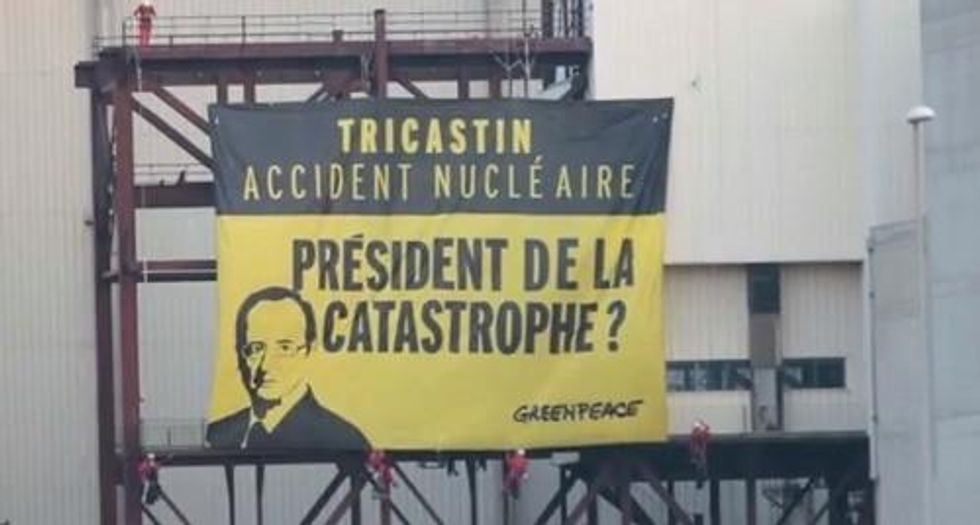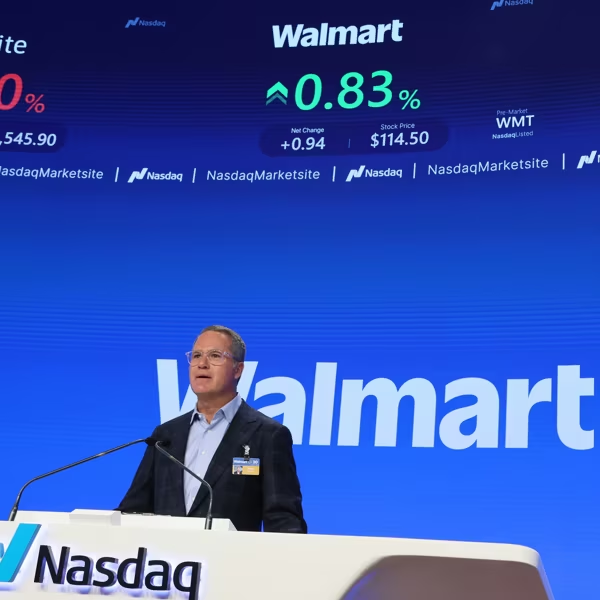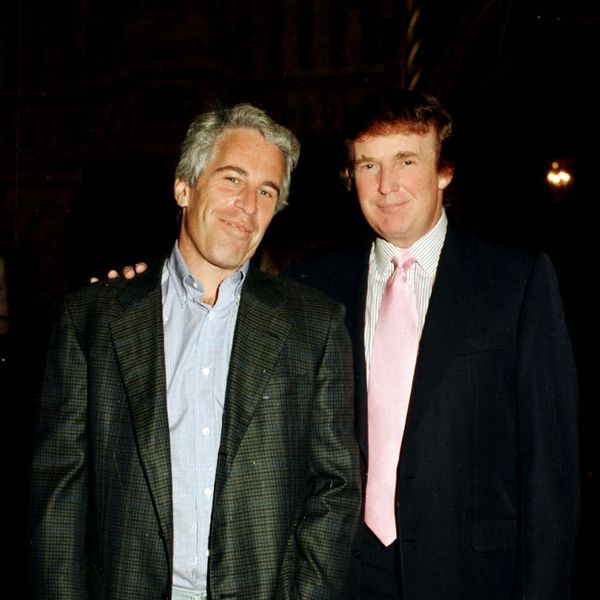'Ready to Pay the Price?' Anti-Nuke Message Delivered to World's Most Nuclear-Dependent Nation
Greenpeace activists storm nuclear power plant, call for plant to be shut down

Ready to pay the price of a nuclear accident?
This is the question left for the president of "the most nuclear-dependent country on earth" by dozens of Greenpeace activists who broke into and occupied what they say is one of France's most dangerous nuclear power plants.
In the pre-dawn action on Monday, the activists climbed fences at the Tricastin nuclear power plant run by Electricite de France (EDF) where they unfurled banners and projected "Tricastin Nuclear Accident" and showed an image of President Francois Hollande's face next to the words "President of the Catastrophe?" and "Ready to Pay the Price?"
"With this action, Greenpeace is asking Francois Hollande to close the Tricastin plant, which is among the five most dangerous in France," Yannick Rousselet of Greenpeace France said in a statement.
Heads of the plant and the Ministry of the Interior dismissed the action as a publicity stunt and said the activists didn't reach sensitive areas, France 24 reports. But Rousselet told Reuters, "If being physically able to touch the reactors is not being in a sensitive place, I don't know what is."
"People with bad intentions could have posed a threat to the reactor's safety," said Rousselet.
BBC News adds:
Jean-Vincent Place, a prominent Green politician and French senator, told Europe 1 radio the Greenpeace action "shows that getting inside one of these extremely dangerous plants is a bit like passing through a sieve".
At the Tricastin plant:
In July 2008, an accident at a treatment centre next to the plant saw liquid containing untreated uranium overflow out of a faulty tank during a draining operation. The same month around 100 staff at Tricastin's nuclear reactor number four were contaminated by radioactive particles that escaped from a pipe. EDF, which runs the site, described the contamination as "slight".
AP reports that by midday, all but two of the nearly 30 activists had been arrested.
Salledepressefr has video:
L'action de Greenpeace dans la centrale nucléaire du Tricastin (version intégrale)Images d'illustration de la projection sur le réacteur et de l'installation de la banderole dans la centrale nucléaire du Tricastin par ...
An Urgent Message From Our Co-Founder
Dear Common Dreams reader, The U.S. is on a fast track to authoritarianism like nothing I've ever seen. Meanwhile, corporate news outlets are utterly capitulating to Trump, twisting their coverage to avoid drawing his ire while lining up to stuff cash in his pockets. That's why I believe that Common Dreams is doing the best and most consequential reporting that we've ever done. Our small but mighty team is a progressive reporting powerhouse, covering the news every day that the corporate media never will. Our mission has always been simple: To inform. To inspire. And to ignite change for the common good. Now here's the key piece that I want all our readers to understand: None of this would be possible without your financial support. That's not just some fundraising cliche. It's the absolute and literal truth. We don't accept corporate advertising and never will. We don't have a paywall because we don't think people should be blocked from critical news based on their ability to pay. Everything we do is funded by the donations of readers like you. Will you donate now to help power the nonprofit, independent reporting of Common Dreams? Thank you for being a vital member of our community. Together, we can keep independent journalism alive when it’s needed most. - Craig Brown, Co-founder |

Ready to pay the price of a nuclear accident?
This is the question left for the president of "the most nuclear-dependent country on earth" by dozens of Greenpeace activists who broke into and occupied what they say is one of France's most dangerous nuclear power plants.
In the pre-dawn action on Monday, the activists climbed fences at the Tricastin nuclear power plant run by Electricite de France (EDF) where they unfurled banners and projected "Tricastin Nuclear Accident" and showed an image of President Francois Hollande's face next to the words "President of the Catastrophe?" and "Ready to Pay the Price?"
"With this action, Greenpeace is asking Francois Hollande to close the Tricastin plant, which is among the five most dangerous in France," Yannick Rousselet of Greenpeace France said in a statement.
Heads of the plant and the Ministry of the Interior dismissed the action as a publicity stunt and said the activists didn't reach sensitive areas, France 24 reports. But Rousselet told Reuters, "If being physically able to touch the reactors is not being in a sensitive place, I don't know what is."
"People with bad intentions could have posed a threat to the reactor's safety," said Rousselet.
BBC News adds:
Jean-Vincent Place, a prominent Green politician and French senator, told Europe 1 radio the Greenpeace action "shows that getting inside one of these extremely dangerous plants is a bit like passing through a sieve".
At the Tricastin plant:
In July 2008, an accident at a treatment centre next to the plant saw liquid containing untreated uranium overflow out of a faulty tank during a draining operation. The same month around 100 staff at Tricastin's nuclear reactor number four were contaminated by radioactive particles that escaped from a pipe. EDF, which runs the site, described the contamination as "slight".
AP reports that by midday, all but two of the nearly 30 activists had been arrested.
Salledepressefr has video:
L'action de Greenpeace dans la centrale nucléaire du Tricastin (version intégrale)Images d'illustration de la projection sur le réacteur et de l'installation de la banderole dans la centrale nucléaire du Tricastin par ...

Ready to pay the price of a nuclear accident?
This is the question left for the president of "the most nuclear-dependent country on earth" by dozens of Greenpeace activists who broke into and occupied what they say is one of France's most dangerous nuclear power plants.
In the pre-dawn action on Monday, the activists climbed fences at the Tricastin nuclear power plant run by Electricite de France (EDF) where they unfurled banners and projected "Tricastin Nuclear Accident" and showed an image of President Francois Hollande's face next to the words "President of the Catastrophe?" and "Ready to Pay the Price?"
"With this action, Greenpeace is asking Francois Hollande to close the Tricastin plant, which is among the five most dangerous in France," Yannick Rousselet of Greenpeace France said in a statement.
Heads of the plant and the Ministry of the Interior dismissed the action as a publicity stunt and said the activists didn't reach sensitive areas, France 24 reports. But Rousselet told Reuters, "If being physically able to touch the reactors is not being in a sensitive place, I don't know what is."
"People with bad intentions could have posed a threat to the reactor's safety," said Rousselet.
BBC News adds:
Jean-Vincent Place, a prominent Green politician and French senator, told Europe 1 radio the Greenpeace action "shows that getting inside one of these extremely dangerous plants is a bit like passing through a sieve".
At the Tricastin plant:
In July 2008, an accident at a treatment centre next to the plant saw liquid containing untreated uranium overflow out of a faulty tank during a draining operation. The same month around 100 staff at Tricastin's nuclear reactor number four were contaminated by radioactive particles that escaped from a pipe. EDF, which runs the site, described the contamination as "slight".
AP reports that by midday, all but two of the nearly 30 activists had been arrested.
Salledepressefr has video:
L'action de Greenpeace dans la centrale nucléaire du Tricastin (version intégrale)Images d'illustration de la projection sur le réacteur et de l'installation de la banderole dans la centrale nucléaire du Tricastin par ...

